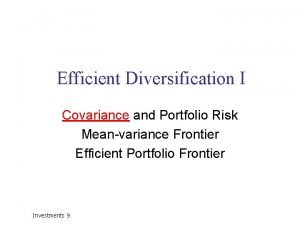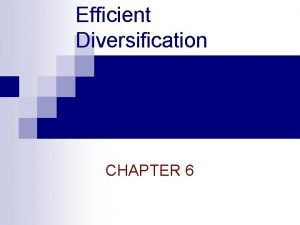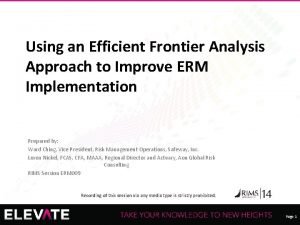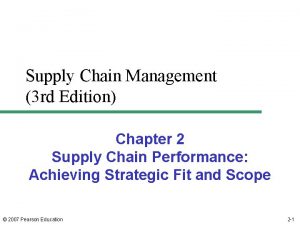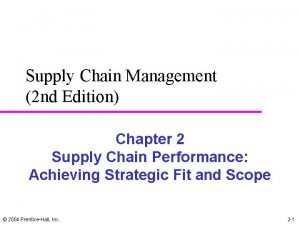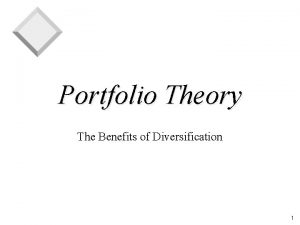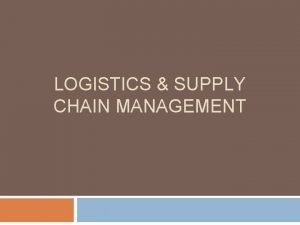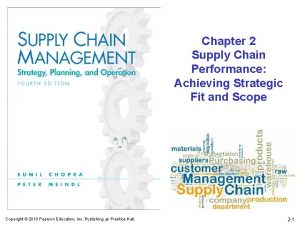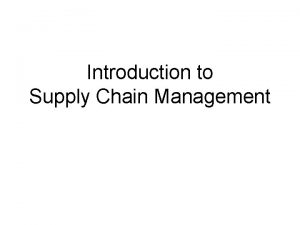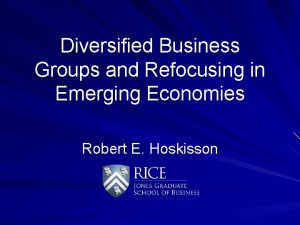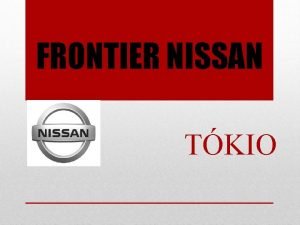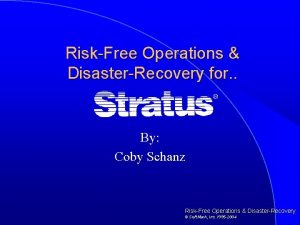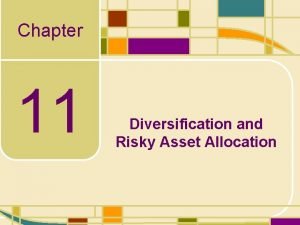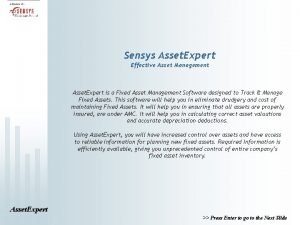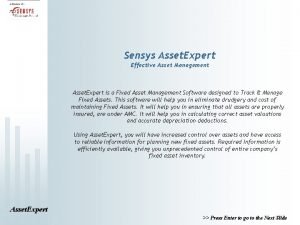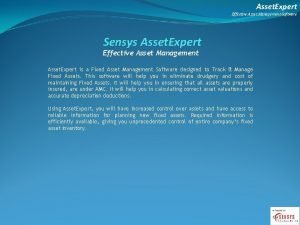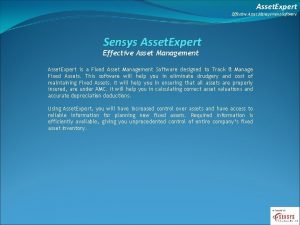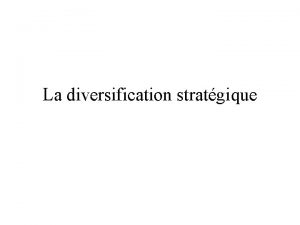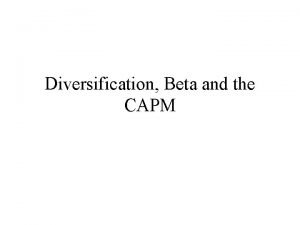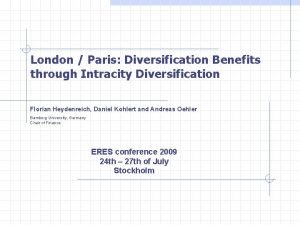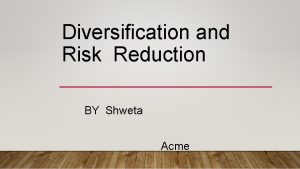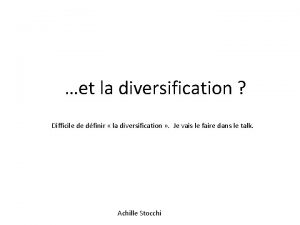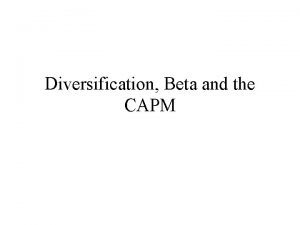Efficient Diversification II Efficient Frontier with RiskFree Asset



![Eff. Frontier with Risk-Free Asset E[r] CAL (P) M M P P CAL G Eff. Frontier with Risk-Free Asset E[r] CAL (P) M M P P CAL G](https://slidetodoc.com/presentation_image_h/2b7f9f49ae932a0f9146528e04d87c78/image-4.jpg)












- Slides: 16

Efficient Diversification II Efficient Frontier with Risk-Free Asset Optimal Capital Allocation Line Single Factor Model

Eff. Frontier with Risk-Free Asset q With risky assets only Ø Ø q No portfolio with zero variance GMVP has the lowest variance With a risk-free asset Ø Ø Zero variance if investing in risk-free asset only How does it change the efficient frontier? Investments 10 2

Optimal CAL q Mean-variance with two risky assets Ø w in security 1, 1 – w in security 2 q Expected return (Mean): q Variance q What happens when we add a risk-free asset? Ø Ø A riskfree asset with rf = 5% What is achievable now? Investments 10 3
![Eff Frontier with RiskFree Asset Er CAL P M M P P CAL G Eff. Frontier with Risk-Free Asset E[r] CAL (P) M M P P CAL G](https://slidetodoc.com/presentation_image_h/2b7f9f49ae932a0f9146528e04d87c78/image-4.jpg)
Eff. Frontier with Risk-Free Asset E[r] CAL (P) M M P P CAL G F P P&F M Investments 10 4

Eff. Frontier with Risk-Free Asset q CAL(P) dominates other lines Ø Ø Ø q Best risk and return trade-off Steepest slope Portfolios along CAL(P) has the same highest Sharpe ratio No portfolio with higher Sharpe ratio is achievable Dominance independent of risk preference How to find portfolio (P)? Investments 10 5

Optimal Portfolio q How much in each risky asset? q The expected return and standard dev. q Sharpe Ratio Investments 10 6

Eff. Frontier with Risk-Free Asset q What’s so special about portfolio (P)? Ø Ø Ø P is the market portfolio Mutual fund theorem: An index mutual fund (market portfolio) and T-bills are sufficient for investors Investors adjust the holding of index fund and T-bills according to their risk preferences Investments 10 7

Optimal Portfolio Allocation Investment Funds y 1 -y P w q Two Step Allocation Ø q T-Bills q 1 -w Ø Bond Step 1: Determine the optimal risky portfolio Stock Step 2: Determine the best complete portfolio q T - Bills Bond 1 -y Investments 10 y×w Stock y×(1 - w) Get the optimal mix of stock and bond Optimal for all investors (market portfolio) q Obtain the best mix of the optimal risky portfolio and T-Bills Different investors may have different best complete portfolios 8

Single Factor Model Ø Ø Ø Quantifies idiosyncratic versus systematic risk of a stock’s rate of return Factor is a broad market index like S&P 500 The excess return is q q q Ø Ø : stock’s excess return above market performance : stock’s return attributable to market performance : return component from firm-specific unexpected event Example: a statistical analysis between the excess returns of DELL and market shows that = 4. 5%, = 1. 4. If expected market excess return is 17%, what is the expected excess return for DELL? Solution: Investments 10 9

Single Factor Model q Security Characteristic Line Dell Excess Returns (i) . . . ß = 1. 4. . . 28. 3% Investments 10 Security Characteristic Line . . . 23. 8%. 4. 5% 17% Excess Returns on market index 10

Single Factor Model q Meaning of Beta ( ) Ø Ø q Indicator of how sensitive a security’s return is to changes in the return of the market portfolio. A measure of the asset’s systematic risk. Example: market portfolio’s risk premium is +10% during a given period, and = 0%. Ø Ø = 1. 50, the security’s risk premium will be +15%. = 1. 00, the security’s risk premium will be +10% = 0. 50, the security’s risk premium will be +5% = – 0. 50, the security’s risk premium will be – 5% Investments 10 11

Single Factor Model q Beta coefficients for selected firms (March 2010) q Question: Ø What are the betas of market index and T-bills? Investments 10 12

Single Factor Model q Systematic Risk Ø Ø q Unsystematic Risk Ø Ø q Risk related to the macro factor or market index Non-diversifiable/market risk Risk related to company specific problems Diversifiable/Firm-specific/Idiosyncratic risk Total risk = Systematic + Unsystematic % of variance explained by the market Investments 10 13

Single Factor Model q Example Ø q Given the following data on Microsoft, analyze the systematic risk, unsystematic risk and percentage of variance explained by systematic risk. (σi= 0. 25, σM= 0. 15, Cov[Ri, RM]=0. 0315) Solution Investments 10 14

Diversification in a Single Factor Security Market q A portfolio of three equally weighted assets 1, 2, and 3. The excess return of the portfolio is q Risk of the portfolio is q Investments 10 15

Wrap-up What does the efficient frontier look like with the presence of a risk-free asset? q What are the two steps of asset allocation? q What is a single index model? q What are the meaning of systematic and unsystematic risks? q Investments 10 16
 Frontier detectors for frontier physics
Frontier detectors for frontier physics Efficient diversification
Efficient diversification Portfolio diversification
Portfolio diversification Efficient frontier case study
Efficient frontier case study Zone of strategic fit in supply chain
Zone of strategic fit in supply chain Interfunctional scope
Interfunctional scope Efficient frontier benefits
Efficient frontier benefits Cost responsiveness efficient frontier
Cost responsiveness efficient frontier Startegic fit
Startegic fit Push pull in supply chain
Push pull in supply chain Allocative efficiency
Allocative efficiency C b a d
C b a d Allocative efficiency vs productive efficiency
Allocative efficiency vs productive efficiency Productively efficient vs allocatively efficient
Productively efficient vs allocatively efficient Allocative efficiency vs productive efficiency
Allocative efficiency vs productive efficiency Conglomerate diversification
Conglomerate diversification Samsung unrelated diversification strategy
Samsung unrelated diversification strategy

